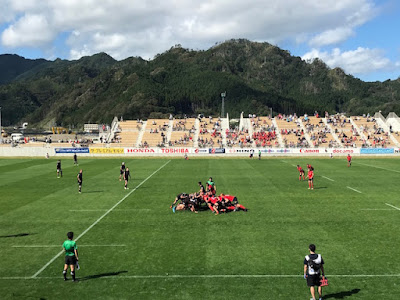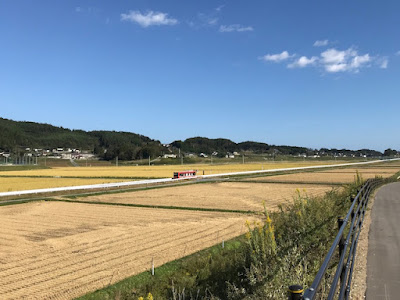釜石〜気仙沼の旅 Traveled Kamaishi to Kesennuma
釜石〜気仙沼を駆け足で旅した。写真は、釜石鵜住居復興スタジアムで、台風の強風下おこなわれた、ラグビー・トップリーグ、キャノン・イーグルス vs. コカ・コーラ・レッドスパークスの試合。フォワード戦は赤のキャノンに分があったようで、43 対 24 でキャノンが勝った。
I traveled Kamaishi to Kesennuma. The picture shows a Japan Top League rugby match, Eagles vs. Red Sparks, at Kamaishi-Unosumai Memorial Stadium. Under a strong wind of typhoon Eagles were superior at forward fights and won by a score of 43-24.
今回の旅は、新しく釜石にできたラグビー場でラグビーの試合があると、試合の前日に知ったことにはじまる。チケット、ホテルに空きがあることを確認して、これらを予約。次の日の早朝、新幹線にとび乗り、釜石駅に着いたのが午前11時前。台風で強風警報が発令される中、試合は無事定刻の11時半にはじまった。
This travel began when knowing there was a rugby game at a brand-new stadium in Kamaishi City on the previous day of the match. Hopping a train next morning, I arrived at Kamaishi station before 11am. The game began at 11:30 under gale warning.
スタジアムがある鵜住居[うのすまい]地区は、津波の被害がとくにひどかった地域である。海沿いの低地は空き地や工事中のところが多い。海岸には巨大な防潮堤が築かれている。こうした光景は、今後の旅の中で、いやというほど目にすることになる。
The stadium was built in Unosumai, one of the most severely damaged areas by tsunami of the 2011 Tohoku earthquake. Most of the lowland near the sea are vacant or under construction. There is a huge embankment at the coast. This was a typical scenery while traveling.
A view toward the north from a crossing near the stadium.
JR山田線の宮古以南は、現在復旧工事がすすめられており、来年2019年3月に、三陸鉄道に移管の上、再開業する。バラストも真新しいから、このあたりの路盤は津波で流され、新たにつくりなおしたのだろう。こうした再生のニュースを聞くのは喜ばしい。釜石鵜住居スタジアムは、もともと小・中学校があった土地につくられた。学校はいまは高台に移転している。ちょうど1年後には、ラグビー・ワールドカップのフィジー vs. ウルグアイ戦ともう1試合とがこの地でおこなわれる。熱い戦いをみせてほしい。
The coastal part of JR Yamada Line has been out of service since the tsunami attack, but it will be transferred to Sanriku Railway and be opened in March, 2019. The clean ballast suggests the rail bed was destroyed by tsunami but constructed again. The stadium was built at the place where there were schools, which have moved to the higher land for safety. Two Rugby World Cup games, Fiji vs. Uruguay and another, are scheduled at this stadium. I hope exciting matches.
試合終了後、あわただしく釜石市街にもどり、バスで釜石鉱山跡にいった。ところでこのバスは岩手県交通が運行しているが、運賃がとても安い。釜石駅から終点の大橋まで 300 円だ。被災した方々の便宜をはかるため、行政が相当の補助をしてきているのだろうが、これは旅行者にとってもうれしい。
After the match I went back to Kamaishi city center and to Kamaishi mine by bus. The bus service is very reasonable. The fare from Kamaishi to Ohashi stations was 300 yen. I guessed the government subsidized the company. This is good for tourists like me.
釜石の中心である大町地区には、市民ホール TETTO のきれいな建物がたち、そのとなりにはイオンのショッピングモールがある。夜はさすがに人影まばらだが、それなりに活気が感じられた。釜石は三陸海岸の中では工業都市として中心的地位にあると思われる。津波被災地、ということで観光に二の足を踏んでいる人も多かろうが、これからどんどん人を呼び込んで、三陸を牽引していってほしい。
In Omachi area, the central part of Kamaishi, there are a brand-new civic hall, TETTO, and a shopping mall. I felt people's energy gradually coming back. Kamaishi is probably the biggest industrial city in Sanriku coast area and hopefully gives a driving force to other coastal towns.
Kamaishi's port and town.
ホテルに一泊し、翌朝、駅前のシープラザ釜石でおみやげを買い、タクシーで観音まで行って、鉄の歴史館を見学。その後、適当なバスの便がなかったので、三陸鉄道の平田[へいた]駅まで歩く。平田地区もまた、津波の被害をうけており、やはり海岸沿いの低地は空き地が多い。それでも新築の家が何軒かたっていて、大きなスーパーマーケットもあった。そこの惣菜コーナーで売っていた「筋子巻き」がめちゃめちゃうまかった。さすがは鮭の本場だ。小学校から正午の音楽がきこえると、盛[さかり]行きのディーゼルカーが来たので、それに乗った。
Staying at a hotel and shopping at Sea Plaza Kamaishi near the station, I went to Kannon by taxi and visited Historical Museum of Iron. After that I walked to Heita station of Sanriku Railway. Heita also suffered damage due to tsunami. A considerable part of the land was vacant, but there are some new private houses near the port. There was also a big supermarket, where I grabbed a nice maki-sushi of suji-ko (salted salmon's eggs). Hearing a music from a school noticing noon, I got on a train for Sakari.
Heita's port and town.
車内はボックス席に固定のテーブルがついていて、ヨーロッパの急行列車のような、豪華な雰囲気だった。リアス式海岸のため、トンネル、入江の町、トンネル、入江の町、という連続である。そして入江の町をとおるたび、白いコンクリートの防潮堤と、その背後に目立つ空き地、という光景を目にする。それでも着実にあたらしい芽が吹き、若葉をひろげているようすがうかがえた。
The seat and table in the train were gorgeous. The scenery from the train is a sequence of a tunnel, a seaside town, a tunnel and a seaside town. Every time when the train passed a town, we saw a big white sea embankment and a vacant land behind. However, I realized that young leaves are steadily growing in every area.
途中、吉浜湾のきれいな景色のところでは、列車はスローダウンして、観光案内をしてくれた。ただ乗客がわたしをふくめて5人だけ(途中2人おりたので、さいごには3人)だったのが、さびしいというか、やはりふつうの観光客はクルマで来るんだろうな、とおもった。
The train slowed down at a viewpoint of Yoshihama bay. But it was sad there were only five passengers in the car (and two of them got off before reaching the last stop). Travelers using public transport are minority.
Viewing Okirai bay from the train stopping at Sanriku station.
三陸鉄道の終点の盛駅からは、列車ではなく、バスになる。JR大船渡線の盛〜気仙沼間は、鉄道の復旧を事実上断念し、BRT(バス高速輸送システム)で輸送を代行している。乗り換え時間が30分ほどしかなかったが、ちょっとは町を見てみたいと思い、タクシーで隣駅の大船渡駅前まで行く。きれいに区画整理された駅前の敷地には、あたらしい建物が何軒かたち、飲食店や商店がはいっていて、とてもにぎわっていた。ここだけ見ると、よくある地方の国道沿いの商業エリアのようである。防災観光交流センターという建物があったのではいってみた。地元の人たちの公民館的な交流スペースのようであった。屋上からは大船渡の港が見渡せた。赤白の大きな煙突は、地元で産する石灰石を原料としたセメント工場のものである。遠くでたくさんの人が集まっていて、イベントかなにかやっているらしかった。
There is no further railway from Sakari station, the southern end of Sanriku Railway. JR Ofunato Line from Sakari to Kesennuma is abandoned because of tsunami, but is replaced with a BRT (bus rapid transit). There was only 30 minutes for transfer, but I took a taxi to Ofunato station, the next stop of BRT, to see the town. The land near the station is readjusted and people enjoyed at restaurants and shops there. There was a public hall and I looked at Ofunato port from the roof. A big red striped chimney is of a cement plant that uses limestone mined nearby. There seemed to be an event away from there where people gathered to do something.
Ofunato's port.
バスに乗り、とくに予定もなかったので、Google Map でみつけた「カキ小屋」でカキでも食べて帰ろうかと画策し、小友[おとも]駅で下車。このあたりも津波被害があった土地である。小友駅は半島のつけねの低地に位置していて、両側から津波が押し寄せたのである。あれから7年たって、いまは黄金色の稲穂がゆれる、のどかな田んぼが広がる。事前に情報をもたない人がこの光景を見たら、まさかこの場所に津波がきたなんて、信じられないだろう。
I got off the BRT car at Otomo station, because I planned to drop in an "oyster shack" that I found on Google Map. The land around Otomo station was also attacked by tsunami. Tsunami waves came from both sides because Otomo is located at the base of a peninsula. After seven and half years, we see a golden rice farm, probably nothing different from before if viewed from a distance.
A red car of BRT going to Otomo station from Takata.
台風一過で日差しが暑く、30分の歩きは運動不足のからだにはなかなかこたえた。途中、三日市[みっかいち]の「地蔵様」があった。もともと三柱あった石碑のひとつで、津波で流されたが、この一柱だけがみつかって、ふただび元の地にまつられている。こうして歴史の糸は切れずにつながっていく。
It was a shiny hot day after a typhoon passed. I saw a stone monument at Mikkaichi. There were two more similar stones and people in Mikkaichi respected them. Tsunami washed them away and only this one was found afterward. A string of history continues ever and ever.
A stone monument in Mikkaichi.
Google Map が指し示す「カキ小屋」に来てみたが、どうも営業している気配がない。ちょうどいま店を市街地に移転中で、休業しているとの張り紙。残念だが仕方ないので、BRT のつぎの駅である脇ノ沢まで歩いた。途中、りんご畑が山の斜面にひろがっていて、そろそろ収穫期が近づいているようだった。高台から見る広田湾には、何事もなかったかのように、養殖カキのいかだが静かに浮かんでいた。これらのいかだも、津波で壊滅的な被害をうけたと聞く。
Walking up to the place that Google Map indicated, I saw a poster saying the oyster bar was moving to another place in the city center. So I walked to Wakinosawa, the next stop of BRT. There were apple farms on hillside. In Hirota bay there were many rafts for oyster farming. Those rafts also suffered devastating damage due to tsunami.
Viewing Hirota bay from near Takata Higashi junior highschool.
陸前高田市は、岩手県の中でももっとも津波の被害が大きかった。地震による地盤沈下も著しいという。大がかりな土木工事が、祝日にもかかわらずつづけられていた。
駅前には、あたらしい町づくりの計画を紹介する施設があった。盛土をほどこした高田の駅周辺は、区画整理され、商店が立ち並び、公園からは子どもたちの声がきこえる。それより海側の低地は、運動公園などの公共施設になるようだ。歩き疲れたので、駅近くの喫茶店でコーヒーを飲み、しばし休んだ。和菓子屋があったので、米まんじゅうをおみやげに買った。高田の松原は津波で押し流されたが、唯一のこった松の木が防腐処理され保存されているので、せっかくだからまたそこまで歩いた。
Rikuzen-Takata City suffered the severest damage due to tsunami in Iwate prefecture. A considerable ground subsidence also occurred. It was a national holiday but construction works were operated everywhere. There was a facility to show the plan of town reconstruction. The ground level near Takata station has been raised and the shopping district is rebuilt. The coastal area will be utilized for public facilities and sports fields. After a long walk I took a rest at a coffee shop near the station. There was a pine tree coast but all of trees have been washed away but one, a miracle pine tree. I walked to see it.
A view of Hirota bay from near Takata station.
A miracle pine tree.
バスで気仙沼についた頃には外はもう真っ暗だった。一ノ関ゆきの列車に乗り換えて、新幹線に乗り、家についたのは夜10時をすぎていた。
When coming to Kesennuma by BRT, the town had been in darkness. Making a transfer to Ichinoseki and riding on Shinkansen, I returned home past ten.
Sake and hoya (sea squirt).
わたしははじめて三陸の地を旅した。この風光明媚な土地に、一度はいってみたいなと、ただ純粋に思っていた。そして7年半前に震災が起こり、この旅には別の意味がつけくわわった。わたしはなんとなく、この震災のことを考えないようにしてきたかもしれない。当時できるかぎりの寄付を赤十字にしたが、おなじ東北出身者として、それ以上に、なにか行動しようとか、思いを寄せようとはしなかった、あるいは、大きな無力感から、できなかった。ただ7年半という時間は長いもので、今回わたしは、純粋な観光旅行として、2日間とても楽しむことができた。こんどは食べれなかったカキを食べに来たいと思う。
This was my first trip to Sanriku coast area. I had thought that I would just like to visit this beautiful place. There was the earthquake seven and half years ago, which added a different meaning to this trip. I think I have not intended to consider this severe disaster. Although I made a contribution to Japan Red Cross as much as possible for me, I didn't made any further action nor think of the earthquake victims, or I couldn't do so because of a kind of impotent feeling. However, the time of seven and half years is long enough for me to enjoy this two-day trip. I would like to visit again to eat oysters that I couldn't this time.











